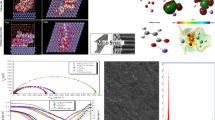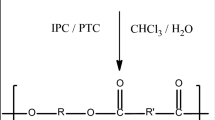Abstract
To prepare a commercial product with economic and technical relevance, polyvinyl acetate (PVAc) was synthesized, under our laboratory conditions, updating an industrial prescription by emulsion polymerization of vinyl acetate using polyvinyl alcohol as emulsifier, Fenton reagent as reaction initiator and acetic acid as aqueous phase pH-regulator. A polymeric film (PSYF) was made and comparatively characterized with a standard PVAc film (PSTF) by scanning electron microscopy with energy-dispersive X-ray spectroscopy, Raman spectroscopy and simultaneous thermogravimetry and derivative thermogravimetry analysis. Similar vibration bands for PSTF and PSYF in the Raman spectra were identified which accurately reproduce the values reported in the literature. Thermal analysis was an efficient method to detect the compositional differences between the two polymeric films, precisely indicating that PSYF contained 92% PVAc and a mixture of 8% containing unreacted monomer, polyvinyl alcohol and humidity. Additionally, the PVAc film inhibitive properties on carbon steel corrosion in acid environments were investigated by potentiodynamic polarization and electrochemical impedance spectroscopy. A high inhibition efficiency of PVAc, ranging between 86.0 and 88.0%, was computed from electrochemical measurements, indicating the polymer adsorption ability on carbon steel surface.







Similar content being viewed by others
References
Jana S, Purkait MK, Mohanty K. Clay supported polyvinyl acetate coated composite membrane by modified dip coating method: application for the purification of lysozyme from chicken egg white. J Membr Sci. 2011;382:243–51.
Jannesari M, Varshosaz J, Morshed M, Zamani M. Composite poly(vinyl alcohol)/poly(vinyl acetate) electrospun nanofibrous mats as a novel wound dressing matrix for controlled release of drugs. Int J Nanomed. 2011;6:993–1003. https://doi.org/10.2147/IJN.S17595.
Aragón J, González R, Fuentes G, Palin L, Croce G, Viterbo D. Development and characterization of a novel bioresorbable and bioactive biomaterial based on polyvinyl acetate, calcium carbonate and coralline hydroxyapatite. Mater Res. 2011;14:25–30. https://doi.org/10.1590/S1516-14392011005000012.
Raţă DM, Popa M, Chailan JF, Zamfir CL, Peptu CA. Biomaterial properties evaluation of poly(vinyl acetate-alt-maleic anhydride)/chitosan nanocapsules. J Nanopart Res. 2014;16:2569. https://doi.org/10.1007/s11051-014-2569-x.
DeMerlis CC, Schoneker DR, Borzelleca JF. Safety of PVAP and PVAP-T including a 90-day dietary toxicity study in rats and genotoxicity tests with polyvinyl acetate phthalate (PVAP). Food Chem Toxicol. 2014;70:231–40.
Lugtu-Pe JA, Ghaffari A, Chen K, Kane A, Wu XY. Development of controlled release amorphous solid dispersions (CRASD) using polyvinyl acetate-based release retarding materials: effect of dosage form design. Eur J Pharm Sci. 2018;124:319–27.
Kolter K, Dashevsky A, Irfan M, Bodmeier R. Polyvinyl acetate-based film coatings. Int J Pharm. 2013;457:470–9.
Kim S, Kim HJ. Effect of addition of polyvinyl acetate to melamine-formaldehyde resin on the adhesion and formaldehyde emission in engineered flooring. Int J Adhes Adhes. 2005;25:456–61.
Pintus V, Wei S, Schreiner M. Accelerated UV ageing studies of acrylic, alkyd, and polyvinyl acetate paints: influence of inorganic pigments. Microchem J. 2016;124:949–61.
Zhang Y, Gu J, Tan H, Shi J, Di M, Zuo Y, Qiu S. Preparation and characterization of film of poly vinyl acetate ethylene copolymer emulsion. Appl Surf Sci. 2013;276:223–8.
Knecht D, Rittig F, Lange RFM, Pasch H. Multidimensional chromatographic techniques for hydrophilic copolymers II. Analysis of poly(ethylene glycol)-poly(vinyl acetate) graft copolymers. J Chromatogr A. 2006;1130:43–53.
Segura T, Menes-Arzate M, León F, Ortega A, Burillo G, Peralta RD. Synthesis of narrow molecular weight distribution polyvinyl acetate by gamma-rays initiated RAFT/MADIX miniemulsion polymerization. Polymer. 2016;102:183–91.
Aruldass S, Mathivanan V, Mohamed AR, Tye CT. Factors affecting hydrolysis of polyvinyl acetate to polyvinyl alcohol. J Environ Chem Eng. 2019;7:103238.
Nwanonenyi SC, Ogbobe O, Madufor IC, Oguzie EE. Influence of polyvinyl acetate on the corrosion inhibition of mild steel in sulphuric acidic environment. Eur J Adv Eng Technol. 2016;3:52–61.
Biswas A, Das D, Lgaz H, Pal S, Nair UG. Biopolymer dextrin and poly (vinyl acetate) based graft copolymer as an efficient corrosion inhibitor for mild steel in hydrochloric acid: electrochemical, surface morphological and theoretical studies. J Mol Liq. 2019;275:867–78.
Nwanonenyi SC, Obasi HC, Oguzie EE, Chukwujike IC, Anyiam CKJ. Inhibition and adsorption of polyvinyl acetate (PVAc) on the corrosion of aluminium in sulphuric and hydrochloric acid environment. Bio Tribo Corros. 2017;3:53. https://doi.org/10.1007/s40735-017-0114-z.
Samide A, Bratulescu G, Merisanu C, Cioatera N. Anticorrosive coating based on poly(vinyl acetate) formed by electropolymerization on the copper surface. J Appl Polym Sci. 2019;136:47320. https://doi.org/10.1002/app.47320.
Hedayati HR, Khorasani M, Ahmadi M. Synthesis of linear high molecular weight polyvinyl acetate by raft polymerization. In: Proceedings of 34th research world international conference, Moscow, Russia, August 9–10, 2017. p. 23.
Oliveira ZM, Barbosa BS, Nele M, Pinto JC. Reversible addition–fragmentation chain transfer polymerization of vinyl acetate in bulk and suspension systems. Macromol React Eng. 2014;8:493–502. https://doi.org/10.1002/mren.201300175.
Radu AL, Damian C, Fruth V, Iordache TV, Zaharia A, Iovu H, Sarbu A. Unique polyvinyl acetate–mesoporous synthetic zeolite composites prepared in ultrasonic field. Micropor Mesopor Mat. 2014;198:281–90.
Boujemaoui A, Mazieres S, Malmstrom E, Destarac M, Carlmark A. SI-RAFT/MADIX polymerization of vinyl acetate on cellulose nanocrystals for nanocomposite applications. Polymer. 2016;99:240–9.
Erbil YH. Vinyl acetate emulsion polymerization and copolymerization with acrylic monomers. Boca Raton: CRC Press LLC; 2000.
Harkins WD. General theory of mechanism of emulsion polymerization. II. Polym Sci. 1950;5:217–51.
Copelli S, Derudi M, Sempere J, Serra E, Lunghi A, Pasturenzi C, Rota R. Emulsion polymerization of vinyl acetate: safe optimization of a hazardous complex process. J Hazard Mat. 2011;192:8–17. https://doi.org/10.1016/j.jhazmat.2011.04.066.
Grecu R, Samide A, Iacobescu GE, Cioateră N, Popescu A. Copper corrosion inhibitors based on polyvinyl alcohol and silver nanoparticles. Chem Ind Chem Eng Q. 2019. https://doi.org/10.2298/CICEQ181027005G.
Samide A, Stoean R, Stoean C, Tutunaru B, Grecu R, Cioateră N. Investigation of polymer coatings formed by polyvinyl alcohol and silver nanoparticles on copper surface in acid medium by means of deep convolutional neural networks. Coatings. 2019;9(2):105. https://doi.org/10.3390/coatings9020105.
Samide A, Tutunaru B, Ionescu C, Rotaru P, Simoiu L. Aminophylline: thermal characterization and its inhibitory properties for the carbon steel corrosion in acidic environment. J Therm Anal Calorim. 2014;118(2):631–9.
Samide A, Rotaru P, Ionescu C, Tutunaru B, Moanţă A, Barragan-Montero V. Thermal behaviour and adsorption properties of some benzothiazole derivatives. J Therm Anal Calorim. 2014;118:651–9.
Samide A, Tutunaru B. Thermal behavior of the chlorophyll extract from a mixture of plants and seaweed. J Therm Anal Calorim. 2017;127:597–604.
Samide A, Tutunaru B. Eurovanillin thermal behaviour and its inhibitory properties on carbon steel corrosion in weakly acidic environments. J Therm Anal Calorim. 2017;127:863–70.
Renuka Devi KB, Madivanane R. Normal coordinate analysis of polyvinyl acetate. Eng Sci Technol Int J. 2012;2:795–9.
Gómez I, Otazo EM, Hernández H, Rubio E, Varela J, Ramírez M, Barajas I, Gordillo AJ. Thermal degradation study of PVA derivative with pendant phenylthionecarbamate groups by DSC/TGA and GC/MS. Polym Degrad Stabil. 2015;112:132–6.
Al-Hassany Z, Genovese A, Shanks RA. Fire-retardant and fire-barrier poly(vinyl acetate) composites for sealant application. Express Polym Lett. 2010;4:79–93.
Author information
Authors and Affiliations
Corresponding author
Additional information
Publisher's Note
Springer Nature remains neutral with regard to jurisdictional claims in published maps and institutional affiliations.
Rights and permissions
About this article
Cite this article
Samide, A., Tutunaru, B., Merişanu, C. et al. Thermal analysis: an effective characterization method of polyvinyl acetate films applied in corrosion inhibition field. J Therm Anal Calorim 142, 1825–1834 (2020). https://doi.org/10.1007/s10973-020-09489-y
Received:
Accepted:
Published:
Issue Date:
DOI: https://doi.org/10.1007/s10973-020-09489-y




